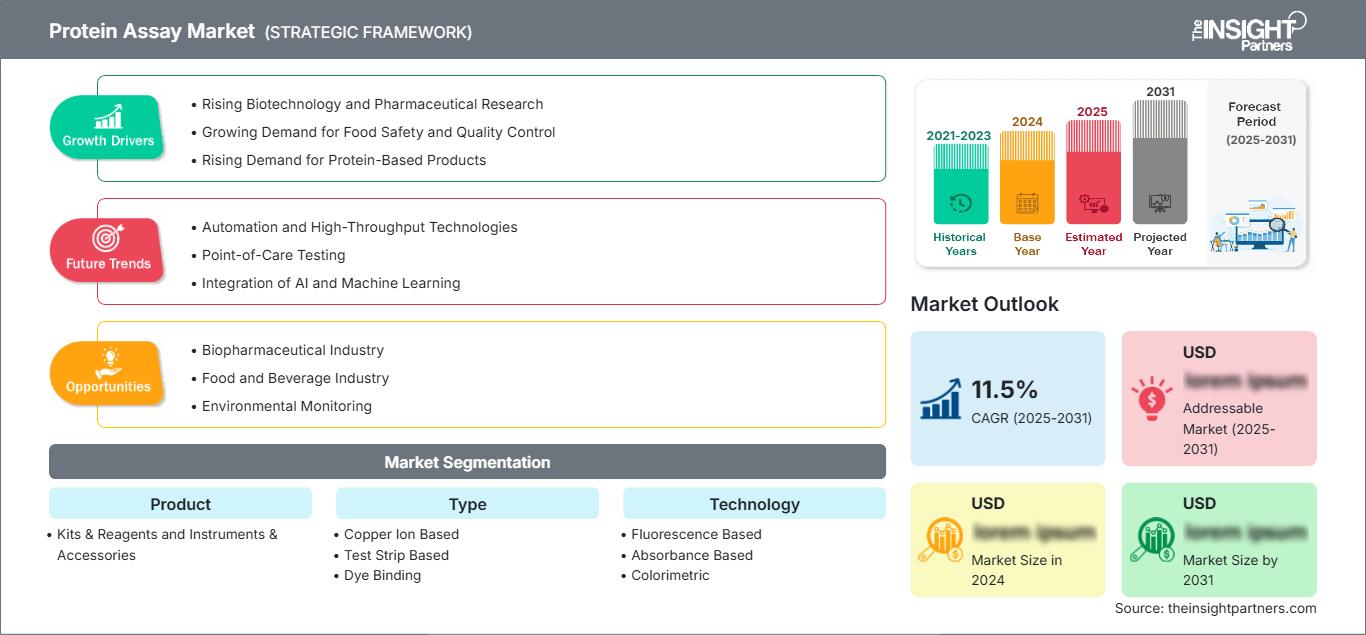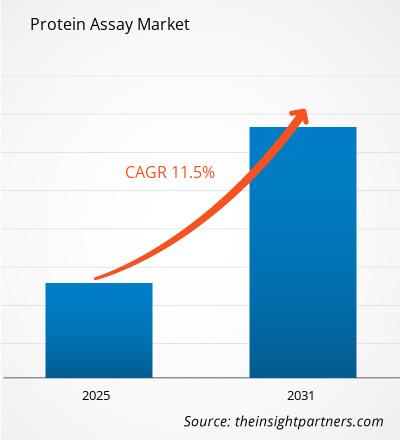Le marché des dosages de protéines devrait atteindre 6 milliards de dollars américains d'ici 2031. Il devrait enregistrer un TCAC de 9,5 % entre 2025 et 2031.
Le rapport est segmenté par produit, type, technologie et application. L'analyse mondiale est ensuite affinée au niveau régional et par principaux pays. L'évaluation du marché est présentée en dollars américains pour l'analyse segmentaire ci-dessus.
Objectif du rapport
Le rapport sur le marché des dosages de protéines, réalisé par The Insight Partners, vise à décrire le paysage actuel et la croissance future, les principaux facteurs de croissance, les défis et les opportunités. Cela permettra d'éclairer divers acteurs économiques, tels que :
- Fournisseurs de technologies/Fabricants : Pour comprendre l'évolution de la dynamique du marché et identifier les opportunités de croissance potentielles, afin de prendre des décisions stratégiques éclairées.
- Investisseurs : Pour réaliser une analyse approfondie des tendances concernant le taux de croissance du marché, les projections financières et les opportunités tout au long de la chaîne de valeur.
- Organismes de réglementation : Pour encadrer les politiques et les activités du marché afin de minimiser les abus, préserver la confiance des investisseurs et garantir l'intégrité et la stabilité du marché.
Segmentation du marché des dosages de protéines
- Kits et réactifs, instruments et accessoires
Type
- À base d'ions cuivre
- À base de bandelettes réactives
- À base de colorants
- Autres types
Technologie
- À base de fluorescence
- À base d'absorbance
- Colorimétrique
Application
- Purification des protéines
- Diagnostic des maladies
- Découverte et développement de médicaments
- Autres applications
Vous bénéficierez d’une personnalisation sur n’importe quel rapport - gratuitement - y compris des parties de ce rapport, ou une analyse au niveau du pays, un pack de données Excel, ainsi que de profiter d’offres exceptionnelles et de réductions pour les start-ups et les universités
Marché des analyses de protéines: Perspectives stratégiques

-
Obtenez les principales tendances clés du marché de ce rapport.Cet échantillon GRATUIT comprendra une analyse de données, allant des tendances du marché aux estimations et prévisions.
Facteurs de croissance du marché des dosages de protéines
- Recherche biotechnologique et pharmaceutique en plein essor : L’intérêt croissant porté à la recherche biotechnologique et pharmaceutique, notamment dans des domaines tels que la découverte de médicaments, l’ingénierie des protéines et les biosimilaires, stimule la demande de techniques de dosage des protéines précises et fiables.
- Demande croissante de sécurité et de contrôle de la qualité des aliments : Les normes réglementaires strictes en matière de sécurité et de contrôle de la qualité des aliments favorisent l’adoption des dosages de protéines afin de garantir la qualité et l’authenticité des produits.
- Demande croissante de produits à base de protéines : La demande croissante d’aliments, de compléments et de produits pharmaceutiques riches en protéines engendre un besoin accru de quantification précise des protéines.
Tendances futures du marché des dosages de protéines
- Automatisation et technologies à haut débit : La demande croissante d’analyses protéiques rapides et efficaces stimule le développement de systèmes de dosage des protéines automatisés et à haut débit.
- Tests au point de soins : Le développement de tests protéiques au point de soins permettra des tests rapides et précis dans divers contextes, notamment le diagnostic clinique et les tests sur le terrain.
- Intégration de l’IA et de l’apprentissage automatique : Les algorithmes d’IA et d’apprentissage automatique sont utilisés pour analyser des données protéiques complexes et améliorer la précision des tests.
Opportunités du marché des tests protéiques
- Industrie biopharmaceutique : L’industrie biopharmaceutique, axée sur les thérapies à base de protéines, est un moteur important du marché des tests protéiques.
- Industrie agroalimentaire : L’industrie agroalimentaire utilise les tests protéiques pour le contrôle de la qualité, les tests d’allergènes et l’étiquetage nutritionnel.
- Surveillance environnementale : Les tests protéiques peuvent être utilisés pour surveiller la pollution environnementale et évaluer l’impact des polluants sur les écosystèmes.
Marché des dosages de protéines
Les analystes de The Insight Partners ont analysé en détail les tendances régionales et les facteurs influençant le marché des dosages de protéines tout au long de la période prévisionnelle. Cette section aborde également les segments et la répartition géographique du marché de la gestion des troubles du rythme cardiaque en Amérique du Nord, en Europe, en Asie-Pacifique, au Moyen-Orient et en Afrique, ainsi qu'en Amérique du Sud et centrale.
Portée du rapport sur le marché des dosages de protéines
| Attribut de rapport | Détails |
|---|---|
| Taille du marché en 2024 | US$ XX Billion |
| Taille du marché par 2031 | US$ 6 Billion |
| TCAC mondial (2025 - 2031) | 9.5% |
| Données historiques | 2021-2023 |
| Période de prévision | 2025-2031 |
| Segments couverts |
By Produits
|
| Régions et pays couverts |
Amérique du Nord
|
| Leaders du marché et profils d'entreprises clés |
|
Densité des acteurs du marché des dosages de protéines : comprendre son impact sur la dynamique commerciale
Le marché des tests protéiques connaît une croissance rapide, portée par une demande croissante des utilisateurs finaux, elle-même alimentée par l'évolution des préférences des consommateurs, les progrès technologiques et une meilleure connaissance des avantages du produit. Face à cette demande grandissante, les entreprises élargissent leur offre, innovent pour répondre aux besoins des consommateurs et tirent parti des tendances émergentes, ce qui stimule davantage la croissance du marché.

- Obtenez le Marché des analyses de protéines Aperçu des principaux acteurs clés
Points clés de vente
- Couverture exhaustive : Ce rapport analyse en détail les produits, services, types et utilisateurs finaux du marché des dosages de protéines, offrant ainsi une vision globale.
- Analyse d'experts : Ce rapport repose sur l'expertise approfondie d'analystes et de spécialistes du secteur.
- Informations actualisées : Grâce à sa couverture des informations et tendances les plus récentes, ce rapport garantit la pertinence de vos analyses.
- Options de personnalisation : Ce rapport peut être personnalisé pour répondre aux besoins spécifiques de vos clients et s'adapter parfaitement à leurs stratégies commerciales.
Ce rapport d'étude de marché sur les dosages de protéines vous permettra ainsi de mieux comprendre le contexte sectoriel et les perspectives de croissance. Malgré quelques points à améliorer, les avantages de ce rapport l'emportent généralement sur les inconvénients.
- Analyse historique (2 ans), année de base, prévision (7 ans) avec TCAC
- Analyse PEST et SWOT
- Taille du marché Valeur / Volume - Mondial, Régional, Pays
- Industrie et paysage concurrentiel
- Ensemble de données Excel
Rapports récents
Témoignages
Raison d'acheter
- Prise de décision éclairée
- Compréhension de la dynamique du marché
- Analyse concurrentielle
- Connaissances clients
- Prévisions de marché
- Atténuation des risques
- Planification stratégique
- Justification des investissements
- Identification des marchés émergents
- Amélioration des stratégies marketing
- Amélioration de l'efficacité opérationnelle
- Alignement sur les tendances réglementaires






















 Obtenez un échantillon gratuit pour - Marché des analyses de protéines
Obtenez un échantillon gratuit pour - Marché des analyses de protéines